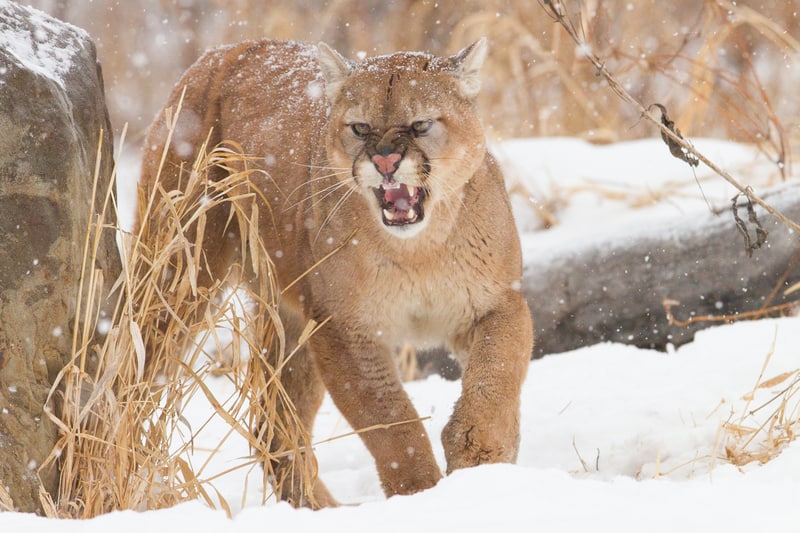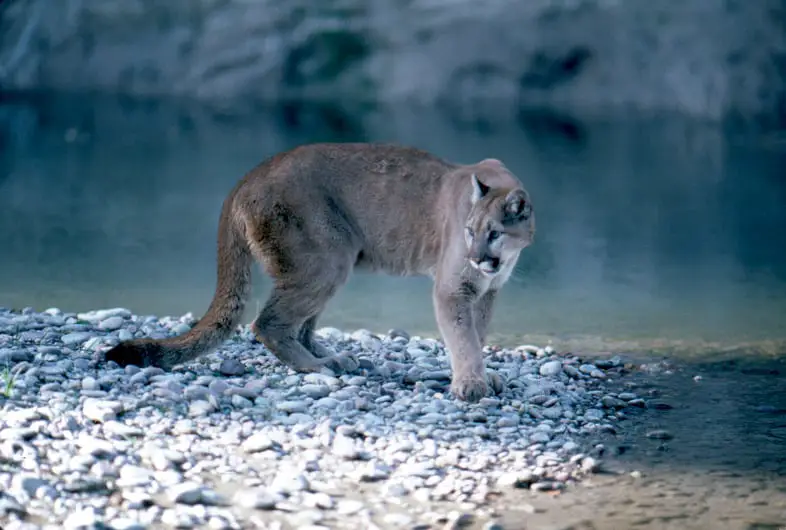The mountain lion is a large, wild cat species known by several different names, depending on the geographical area. Other names mountain lions go by include; cougars, pumas, painters, catamounts, and panthers. The mountain lion is a native of the Americas. They live in a wide range of habitats that spread from the upper regions of the Yukon territory in Canada all the way to the southern portions of the Andes in South America. Because mountain lions live in various habitats, you may be living with mountain lions in your own area. If so, learning more about these predatory creatures can help you to co-exist with them safely.
You’ll recognize a mountain lion by its simple and basic “cat-like” features and systematic color markings. Their fur is short and tawny-beige until it reaches its chest, where they sport a grayish to pure white coloring. In contrast to the white, you’ll typically find black markings on their muzzle, the tips of their ears, and at the tip of the tail. Like many animals, the males are typically larger than females, weighing anywhere between 140 to 180 lbs. An adult female will rarely exceed 110lbs. Source
Where Do Mountain Lions Live?
- Mountain Lions live where deer are present. They prefer rocky, steep canyon country or mountainous areas filled with plenty of underbrush. This is something that aids them in stalking their prey. They can also make their homes in the desert or coastal forest environs.
- In the United States, there are populations of cougar in Washington, Oregon, California, Nevada, Arizona, Utah, Idaho, Montana, Wyoming, Colorado, Nebraska, New Mexico, South Dakota, North Dakota, Texas, and Florida. Source Of those, California has the largest share.
- In Canada, the western provinces have the most mountain lions. British Columbia has the largest share of those. British Columbia has around 3,500 cougars. Around 1500 of those living on Vancouver Island. Vancouver Island has the largest concentration of cougars in the world. Source
What Do Mountain Lions Eat?
Cougars are like any cat when it comes to their diet. They are carnivores and love to hunt for a good piece of meat. Their first choice of prey animals is a deer. In the absence of deer meat, they’ll prey on other ungulate animals. They also hunt small animals, such as mice, rats, rabbits, and squirrels. A farmers’ sheep and cattle, or even a domestic pet, will sometimes be on the menu.
The Sounds a Cougar Makes
Cougars make an array of noises. They growl, hiss, shriek, and purr. What they don’t do is roar. This is different from larger cat species, such as the lion. If you should encounter a mountain lion somewhere, it’s possible you could hear any one of the loud noises it makes. Just don’t expect to hear it purr.

When Do Cougars Hunt Their Prey?
Mountain lions are nocturnal animals. Although they can be spotted during the day, they are mostly night prowlers. They move about looking for food during the night. With their keen eyes, they can see great in the dark. Most of the animals they hunt don’t see in the dark nearly as well as they do. Consequently, nighttime hunting gives them a huge advantage over their prey.
Beginning at a young age, cougars are taught how to attack their prey most effectively to make the kill. For a cougar, that’s going for the spine. These animals know exactly where to attack their prey so that it paralyzes them and renders them helpless. Once the animal is immobile, it can finish the job and enjoy its meal.
Are Cougars Aggressive Towards Humans?
Yes, but rarely. The following is a quote from the Mountain Lion Foundation.”
The historical average odds of anyone being fatally attacked by a mountain lion in the United States is about one in a billion, or three times LESS likely than that same individual getting the winning numbers in tonight’s Powerball Lottery.
In the past 25 years, there have been only seven fatal mountain lion attacks in the United States.
This is a 28% chance (7 divided by 25) of this event occurring in any year in the United States.
The US population is currently 321 million, but over the past 25 years, the average population was 299 million.“
Which makes the odds of being fatally attacked by a mountain lion one in 1,068,681,429, just a little more than one in a billion!” Source
Logical thinking brings me to the conclusion that the above data is skewed to support a specific agenda. I’ll give you an example. If I live in the wilderness of Arizona, my odds of being attacked are much greater than if I never leave one of our major population centers.
From Wikipedia, In North America, in the past 100 years, there have been 125 mountain lion attacks. 27 of those have been fatal. The majority of fatal attacks have been on children who were unaccompanied by adults. Source If you have young children and you live in cougar country, that’s something to consider. Small children ought to never go unsupervised in cougar country.

How Do You Know If a Mountain Lion is Near You?
Mountain lions may be large cats, but they are light on their feet, quiet, and sneaky. They can hide in trees and appear out of nowhere or sneak up on you out of the brush. You may hear some movement in the brush before it suddenly appears, or you might not.
Mountain lions are territorial animals, which means they will mark and protect their territory. Some of the ways they mark it are with claw marks, the smell of their feces, and natural odors they emit, called pheromones.
Other signs that mountain lions are in the area might include; mountain lion tracks (if you know what to look for). The rule-of-thumb is, a cat’s print will have one toe print in front of the others. A K9’s toe prints will all be level in appearance. In a K9’s track, the claws will be present. This isn’t so most of the time with a cat track. They have retractable claws.
You might also come across their scat, which could harbor hair from the past prey they ate. If you see deer or other animals around that, a mountain lion would consider prey. There’s a probability mountain lions are around. Even an old carcass of an animal lying in the area can indicate mountain lions are near. They may have had that animal as a meal, or they may come later to gnaw on the carcass of another animal’s kill.
What To Do If You Encounter a Cougar?
You might encounter a cougar on a hiking trail in the mountains or woods, or perhaps one could wander onto your property in a rural area or even a neighborhood – depending on where you live. If you should happen upon a cougar, the worst thing you could do is to run. This could instigate the animal’s instinct to chase. Don’t turn your back on the animal, but make slow movements away from it while talking firmly but calmly. This can help to keep the animal from growing aggressive.
The trick is to make yourself appear as if you are larger than the animal rather than something that should be viewed as its prey. If the cougar does become aggressive, throw what you can at it; sticks, stones, branches, or whatever you can grab without turning away from it or getting into a crouched position, which will make you more vulnerable and will allow it to pounce.
How do you survive a cougar attack?
Playing dead doesn’t work with the cougar. All it does is make it easier for the animal to eat you. Fight back if a mountain lion attacks you. People have successfully warded off mountain lions with rocks, sticks, garden tools, and even jackets and caps. The animal will be looking to attack your skull or neck. Keep your feet if you can, and face the animal at all times. This is a fight for your life, so don’t hold back. Swing for the cat’s most vulnerable areas, such as its eyes, throat, nose, and head. Hit it as hard as you can. Your will to live will make all the difference. In 2019 a Colorado man killed an attacking mountain lion with his bare hands.
Some experts advocate carrying bear spray on hiking trips, just in case. Yes, the bear spray works on cougars too, and whether you are new to hiking or spend a great deal of time on the trails, carrying the right tools for the unexpected is always a smart move.
Be Prepared But Don’t Be Scared.
I’ve already established that the chances of being attacked by a Mountain Lion are mind-bogglingly small. Don’t let the thought of it worry you but be prepared. Remember you’re responsible for your own safety and those around you, then get out there and enjoy the outdoors.
Also, see Do Mountain Lions Hibernate?
Recent Posts
The only venomous snakes in Washington State are Northern Pacific Rattlesnakes. The Northern Pacific Rattlesnake (Crotalus oreganus oreganus) is a sub-species of the Western Rattlesnake. Anyone...
Skunks are not classified as true hibernators. But they go into a state of torpor when the weather gets cold. Skunks are light sleep hibernators, along with opossums, bears, and raccoons. ...

